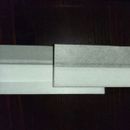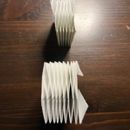Cellular Shades and Insulation: What matters the most?
We are looking at adding cellular shades to a four-season room, which is already quite well insulated, but does have many, large windows. We are going to go for the double-cell kind, light-filtering (that is, not blackout).
This guest post discussed the Ecosmart shades (but, judging from the photo, the blackout ones):
https://www.greenbuildingadvisor.com/article/insulating-window-shades
A user’s comment mentions Symphony Shades as a similar product.
Yet, one can get double-cell shades from the big-box stores, too (brands like Bali and Levolor).
I wonder what people’s thoughts are on what matters to R-value:
– Size? The Ecosmart ones are considerably smaller (hence, smaller width and smaller size of each “cell”). See attached photos.
– Materials (when comparing light-filtering models). The Ecosmart seem to be made of a fabric that is slightly thinner.
Any thoughts? Thanks!
GBA Detail Library
A collection of one thousand construction details organized by climate and house part











Replies
Peter Yost contributed to this non-profit site and it has a ton of good information:
https://efficientwindowcoverings.org/
Thank you!
Here is my non-expert opinion. I have double cellular shades throughout my entire house, many are blackouts. Keep in mind there will always be a gap on the sides and bottom so take R value with a grain of salt. They do keep the house cooler in the summer when I close the south facing windows. One of the problems in the winter is that if it is really cold outside any condensation on the window will freeze if the shade is down as not enough heat is hitting the interior glass. I do have double pane windows. For this reason I am always leaving a 1 inch gap at the bottom when I pull them down at night in the winter. If I had to do it again I would have looked into any external shades on the market that could be controlled by wifi and are powered by solar or battery - if such a product exists.
Yes, in cold climates, even with new triple pane/low E fixed units, the cellular shades will reduce heat to the interior glass and you will likely see condensation or freezing with lower efficiency windows/glass. We have either triple glaze or double pane with acrylic inner storms and if closed completely (zone 7A with interior RH at 35-40%) the cellular shades can cause a significant quantity of condensation/moisture issues (none of them actually freeze) on the windows. We have to leave a pretty good gap at top/bottom and ensure there is an air space between shades/glazing to resolve this issue, more or less obviating any insulation value. Adding insulation without air sealing on the interior of a cold climate window is something you don't want to do.
Interior acrylic storms in contrast do increase the efficiency of a double glazed double hung unit to levels similar to our new triple glazed/fixed units. Because they are decently air sealed, there are no condenation issues.
Here's a link to an excellent evaluation of cellular shade insulation:
http://www.residentialenergylaboratory.com/r_value_cellular_shades.html
Bottom line: the study found that cellular blinds can achieve advertised R-values under very specific conditions, but only with side seals.
I wonder about using insulating blinds in summer. It seems they could result in window temperatures high enough to damage seals.
Also: a great writeup from way back (2013) from Marc Rosenbaum:
Insulating Window Shades
Ecosmart cellular window shades can add R-4 insulation to your window opening
https://www.greenbuildingadvisor.com/article/insulating-window-shades